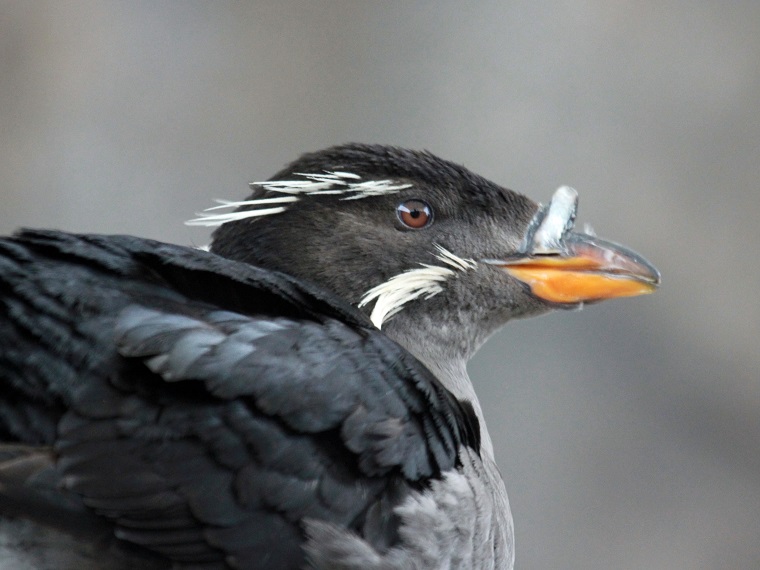Fishing for Answers: Using Seabirds to Better Understand Fish Populations
By Madison Wright
26 February 2019

To trawl or not to trawl? Trawling is the gold standard method for determining which fish species are present in a body of water and the abundance of each species. It involves casting a large net in the body of water and capturing lots of fish. This method is efficient because it can cover a large area, but it comes at a very damaging price to the environment.
Prof. Shoshanah Jacobs in the Department of Integrative Biology explains that, with trawling, “you are either effectively killing all the fish, hurting them in some way, or you are displacing them from their original habitat if you release them.” On top of the damage to the fish, trawling also adds an incredible amount of pollution to the water due to the ship burning fossil fuels.
Jacobs is a bird ecologist who, along with fellow Integrative Biology researcher Prof. Karl Cottenie and graduate student Joshua Cunningham, believes there may be a better way to study fish populations. Working with colleagues at McGill University and the Institute for Seabird Research and Conservation, the team set out to determine if fish-eating seabirds could be used to collect data on fish populations that would be as useful, if not better, than the conventional trawling method.
Cunningham spent several summer months on Middleton Island in Alaska studying what type of fish rhinoceros auklets collect to feed their offspring. Auklets catch a big mouthful of fish, which can be made up of a number of different forage fish species (forage fish are what economically important fish, such as salmon and trout, eat). Because auklets don’t target a specific type of fish as their prey, each mouthful is like a random sample of the population of forage fish.

Cunningham in the field
with an auklet nestling
(photo by S. Jacobs)
Every night, parent auklets go on fishing expeditions to catch food for their offspring and luckily for Cunningham, they are very predictable birds. They fly back to their nest following the same route each night. This made it easy for Cunningham to set up a net and wait to catch an auklet. After netting a bird, Cunningham collected the contents of its mouth and identified the fish down to the species level. One auklet typically carries six fish in its mouth, and during this study, the researchers were able to collect a total of 2228 mouthfuls!
Many of the birds Cunningham netted were part of a long-term bird study being carried out in the Gulf of Alaska, which meant that they wore special GPS trackers. These trackers also allowed the researchers to determine where these auklets found their prey and how deep they had to dive to reach it.
With several years of auklet diet data in hand, the team found that auklets caught different types of fish when some species were more abundant than others, and that the bird’s diet was also influenced by seasonal temperatures. For example, in colder years auklets consumed more of a forage fish known as capelin, while in warmer years auklets tended to catch more Pacific sand lance.
They also found that auklets were catching Pacific sand lance in areas that trawling methods had not previously detected, showing that seabirds may be able to determine the presence of certain fish species with greater resolution than trawling.
After evaluating all the data, the researchers concluded that the best way to study aquatic populations would be to use trawling on a large scale and look at seabird diets on a small scale. Because each method has its own advantages and disadvantages, the ideal solution would be to use a combination of both techniques.
In addition to being more cost effective than trawling, the researchers noted that seabird diets have “added value” as a fish monitoring tool. For example, in this particular study, Cunningham’s efforts contributed valuable data to a long-term bird study in the region.
Biological tools are often the best tool to answer biological questions, notes Jacobs. “If we are asking questions about how climate change affects biology, using a technological tool is not necessarily the most useful. Using a biological tool might provide even greater detail than you expected.”
The data collected in this study can also act as early warning signs for environmental change. “Each species of forage fish has its preferred temperature, depth, pH and salinity. If you notice any changes in a certain species then you can tie them back to the changes in the body of water,” says Jacobs.
Moving forward, Jacobs and Cunningham are continuing to study other seabird species in Alaska and how their populations have changed overtime.
“Birds are cool and they can tell us a lot. We know this – this isn’t the first paper to do this by any means. There is no one ideal model species that is going to tell us everything. It is more of a conversation and compilation that together will give us more information about the environment,” says Jacobs.
This study was funded by the Northern Scientific Training Program.
Read the full study in Marine Ecology Progress Series.
Read about other CBS Research Highlights.